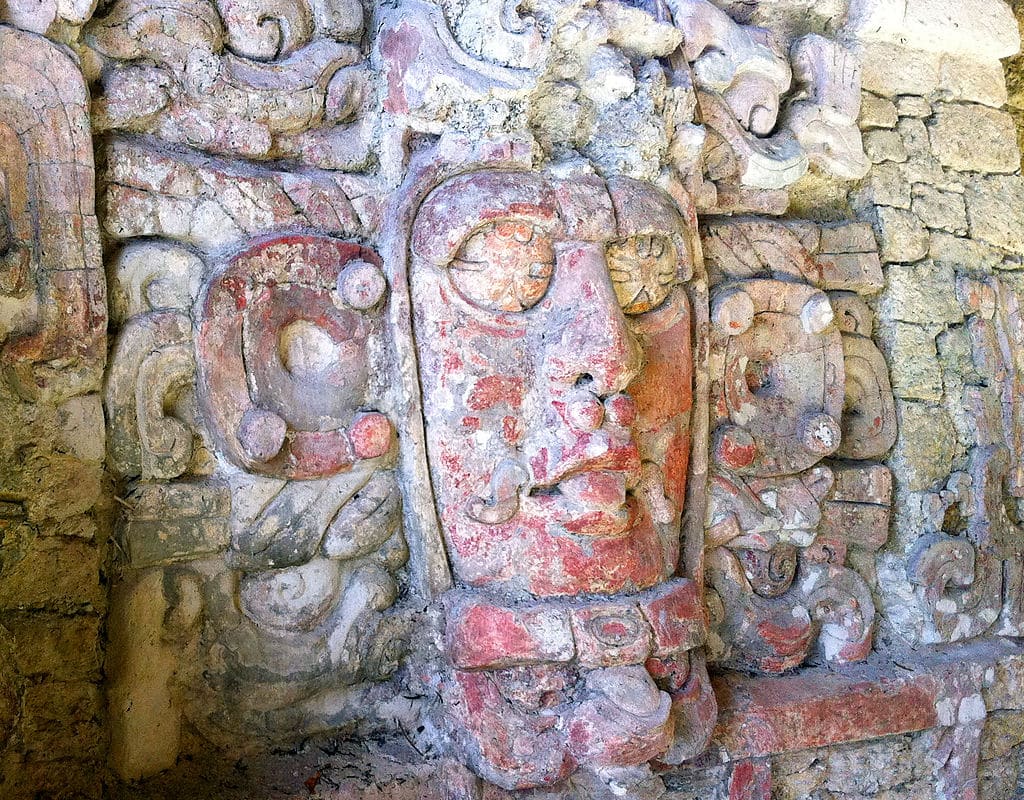The Language Mix-Up of The Kohunlich ruins

Kohunlich has impressive architectural features, including the striking “mascarones” (masks). While not as famous as some of the other Mayan sites in the region, Kohunlich offers a fascinating glimpse into the past. As well as a curious story behind its name. Located near the city of Chetumal, Kohunlich is an ideal destination for a day trip. Here are some tips on the Kohunlich ruins.
The Famous “Mascarones” of Kohunlich
One of the most impressive features of Kohunlich is the series of large stucco masks, or “mascarones”. You can find them at the Temple of the Masks. These large, carved faces may have represented the sun god Kinich Ahau. He is one of the most important deities in Mayan religion. The mascarones, which stand over 6 feet tall, are beautiful in detail. They feature elaborate headdresses and expressive facial features. Originally in bright colors, these masks once stood as powerful symbols. Especially of the Mayans’ reverence for the sun and its life-giving energy.
The English-Spanish Mix-Up: How Kohunlich Got Its Name
The name Kohunlich is the result of a curious mix-up involving English and Spanish. Contrary to what some might expect, the name does not derive from the Mayan language. Instead, it comes from the English name “Cohune Ridge,” which referred to an area where cohune palm trees were abundant. In the early 20th century, this region was known as Clarksville, named after a logging camp located 3 kilometers north of the archaeological site. When the site was later studied by archaeologists, the English “Cohune Ridge” transformed into the more Spanish-sounding “Kohunlich.”
Kohunlich: A Perfect Day Trip from Chetumal
Kohunlich is about 37 miles from the city of Chetumal. This makes it a perfect day trip for those looking to explore beyond the usual tourist spots. The short drive offers visitors a chance to experience the quiet beauty of the Quintana Roo countryside, with opportunities to see local wildlife and rural communities along the way.
Once at the site, visitors are treated to a peaceful, uncrowded experience, as Kohunlich is less frequented than other Mayan sites like Tulum or Chichen Itza. The serenity of the site, coupled with its lush jungle surroundings, makes it an ideal destination for history lovers and those looking for a deeper connection with nature.
The Ingenious Water System of the Kohunlich ruins
One of the lesser-known but fascinating features of Kohunlich is its sophisticated water management system. The ancient Maya of Kohunlich were highly skilled engineers, and they designed a series of reservoirs and canals to collect and store rainwater. Given the site’s location in a region that experiences both dry and rainy seasons, the water system was essential for sustaining the city’s inhabitants.
The largest reservoir at Kohunlich is located in the central plaza, where rainwater was funneled from the surrounding structures into the reservoir for storage. This ingenious system allowed the Maya to maintain a stable water supply year-round, ensuring the survival of the city during dry periods. The site’s water management system is a testament to the advanced knowledge and resourcefulness of the ancient Maya.
The Kohunlich ruins: A Blend of History and Nature
Kohunlich is a site where history, nature, and culture converge. From the majestic “mascarones” that guard the ancient city to the linguistic quirks that gave the site its name, Kohunlich offers a truly unique experience for those interested in exploring the depths of Mayan civilization. Whether you’re visiting for a day trip from Chetumal or simply want to explore its intricate water systems, Kohunlich is a hidden gem in the heart of the Yucatán Peninsula.
